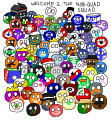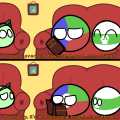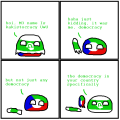 |
This page is about an important IRL ideology "This knowledge is essential to political science!" - Scientocracy This page is about an ideology that not only exists in the real world, but is also of reasonable importance. Please do not make major edits to this page without citing sources, so that it may stay accurate. |
For the ideology of the US Democratic Party see Error creating thumbnail: Unable to save thumbnail to destination Big Tent Liberalism, Error creating thumbnail: Unable to save thumbnail to destination Third Way or Error creating thumbnail: Unable to save thumbnail to destination Social Liberalism.
Democracy (Dem) is a non-quadrant ball used to represent democracy without any more adjectives. Dem believes that the people residing within a state all have the right to decide rules, policies, leaders, etc. based off what most people want. Dem is also not to be confused with Error creating thumbnail: Unable to save thumbnail to destination Republicanism.
Variants
Error creating thumbnail: Unable to save thumbnail to destination Representative Democracy
Representative democracy also called Error creating thumbnail: Unable to save thumbnail to destination Republican democracy or indirect democracy is a form of government in which the people elect representatives who administer, establish and execute all the interests of the population. This is by far the most common variant, with almost all established democracies currently using it.
Error creating thumbnail: Unable to save thumbnail to destination Semi-Direct Democracy Error creating thumbnail: Unable to save thumbnail to destination
Semi-direct democracy is a variant of democracy that combines direct and representative democracy. In this system, the rulers are elected by the people, but the citizens maintain sovereignty through, for example: referendum, public consultation, popular initiative and revocation of the mandate. It is currently practiced in Switzerland, Liechtenstein and at the local level in most of the United States.
Error creating thumbnail: Unable to save thumbnail to destination Direct Democracy
Direct democracy is a variant where the population is given full control over policy making rather then having to elect legislators like in a Representative Democracy. Historically practiced in Ancient Greece in the city of Error creating thumbnail: Unable to save thumbnail to destination Athens, Error creating thumbnail: Unable to save thumbnail to destination Revolutionary France and the Error creating thumbnail: Unable to save thumbnail to destination Paris Commune, it is nowadays practiced in the autonomous region of Error creating thumbnail: Unable to save thumbnail to destination Rojava and in Error creating thumbnail: Unable to save thumbnail to destination Chiapas.
Error creating thumbnail: Unable to save thumbnail to destination Defensive Democracy
Defensive democracy is a term referring to the collection of laws, delegated legislation, and court rulings which limit certain rights and freedoms in a democratic society in order to protect the existence of the state, its democratic character, institutions and human rights. The term describes a major conflict that may emerge in a democratic country between compliance with democratic values, particularly freedom of association and the right to be elected, and between preventing anti-democratic parties, groups and persons from abusing these principles.
In certain democratic states there are additional special distinctions, supported by a notable section of the population, which justify the use of defensive democracy. However, the question of in what situations the use of defensive democracy is justified without this being considered excessive repression of civil rights is disputed. To some extent this can be argued to be a form of Error creating thumbnail: Unable to save thumbnail to destination Authoritarian Democracy.
Economic Democracy
Economic democracy (sometimes called a Democratic Economy) is a socioeconomic philosophy that proposes to shift ownership and decision-making power from corporate shareholders and corporate managers (such as a board of directors) to a larger group of public stakeholders that includes workers, consumers, suppliers, communities and the broader public.
Error creating thumbnail: Unable to save thumbnail to destination Non-Partisan Democracy
Nonpartisan democracy, also known as a No-Party Democracy, is a system of representative government or organization such that universal and periodic elections take place without reference to political parties. Sometimes electioneering and even speaking about candidates may be discouraged, so as not to prejudice others' decisions or create a contentious atmosphere.
Error creating thumbnail: Unable to save thumbnail to destination Demobureaucracy
Demobureaucracy is a term referring to the hypothetical system where the right to be elected by the general public extends at least throughout the seniormost offices in public administration. The term may describe various processes whereby the administrative offices are generally elected from a pool of self or chief-executive-selected, but particularly chief-executive-selected candidates. To some extent, this can be argued to be what Woodrow Wilson was trying to talk about in this passage of an article he wrote:
But to fear the creation of a domineering, illiberal officialism as a result of the studies I am here proposing is to miss altogether the principle upon which I wish most to insist. That principle is, that administration in the United States must be at all points sensitive to public opinion. A body of thoroughly trained officials serving during good behavior we must have in any case: that is a plain business necessity. But the apprehension that such a body will be anything un-American clears away the moment it is asked. What is to constitute good behavior? For that question obviously carries its own answer on its face. Steady, hearty allegiance to the policy of the government they serve will constitute good behavior. That policy will have no taint of officialism about it. It will not be the creation of permanent officials, but of statesmen whose responsibility to public opinion will be direct and inevitable. Bureaucracy can exist only where the whole service of the state is removed from the common political life of the people, its chiefs as well as its rank and file. Its motives, its objects, its policy, its standards, must be bureaucratic. It would be difficult to point out any examples of impudent exclusiveness and arbitrariness on the part of officials doing service under a chief of department who really served the people, as all our chiefs of departments must be made to do. It would be easy, on the other hand, to adduce other instances like that of the influence of Stein in Prussia, where the leadership of one statesman imbued with true public spirit transformed arrogant and perfunctory bureaux into public-spirited instruments of just government.
Error creating thumbnail: Unable to save thumbnail to destination Democratic Globalization
Democratic Globalization is social movement which is aimed for the creation of a institutional system of global democracy. This social movement stems from the international theory of Error creating thumbnail: Unable to save thumbnail to destination cosmopolitanism. The stated purpose of democratic globalization by proponents is to make people around the world more united. This form of globalization differs from economic globalization, as some proponents of the anti-globalist movement do not necessarily disagree with these positions.
Error creating thumbnail: Unable to save thumbnail to destination Deliberative Democracy
Deliberative democracy is a form of democracy in which deliberation is considered central to good legislation. It adopts elements of both consensus decision-making and majority rule. Deliberative democracy differs from traditional democratic theory in that authentic deliberation, not mere voting, is the primary source of legitimacy for the law. Deliberative democracy is closely related to consultative democracy, in which public consultation with citizens is central to democratic processes.
Error creating thumbnail: Unable to save thumbnail to destination Democratic Centralism
Democratic Centralism is a practice in which political decisions reached by voting processes are binding upon all members of the political party. It is mainly associated with Error creating thumbnail: Unable to save thumbnail to destination Leninism, wherein the party's political vanguard of professional revolutionaries practized democratic centralism to elect leaders and officers, determine policy through free discussion, and decisively realize it through united action. Democratic centralism has also been practiced by social democratic and democratic socialist parties as well.
Error creating thumbnail: Unable to save thumbnail to destination Democratic Transhumanism Error creating thumbnail: Unable to save thumbnail to destination
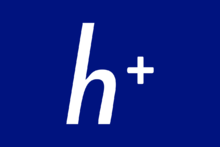
Democratic Transhumanism, shortened to Demh+, is a Error creating thumbnail: Unable to save thumbnail to destination democratic, often Error creating thumbnail: Unable to save thumbnail to destination culturally progressive, pro-technology ideology.
Democratic Transhumanism believes that the concept of Error creating thumbnail: Unable to save thumbnail to destination Transhumanism would fit within a Error creating thumbnail: Unable to save thumbnail to destination liberal, Error creating thumbnail: Unable to save thumbnail to destination social and/or radical democratic society, supporting equal access to human enhancement technologies in order to promote social equality and to prevent further divide between the socioeconomic classes.
James Hughes has referred to "Error creating thumbnail: Unable to save thumbnail to destination techno-progressivism" as another name for Democratic Transhumanism, but it can also refer to the support of both technological and social reform in general.
Personality
In all contexts in which there's a debate, Dem will always suggest it to settle out with a vote. Sometimes in a comedic context, Dem might support a radical decision simply because there was a vote on it.
How to Draw
Representative Democracy
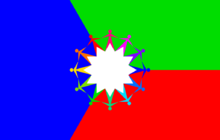
The design of Democracy utilizes this flag uploaded to Wikimedia Commons in 2011.
- Draw a ball with eyes.
- Separate the Ball into 3 roughly equal sized sections;
- Blue, on the left, in a triangle-like shape,
- Red, the bottom right,
- Green, top right.
- In the middle draw a white circle.
- Around the middle Circle draw smaller circles with the colours mentioned before (Red, Green and Blue) and the 3 combinations of those colours (Yellow, Purple and Cyan) in a positions physically opposite of each other.
You're done!
| Color Name | HEX | RGB | |
|---|---|---|---|
| Green | #21B14C | 33, 177, 76 | |
| Blue | #3F47CB | 63, 71, 203 | |
| Red | #EC1D24 | 236, 29, 36 | |
| Magenta | #FF00FF | 255, 0, 255 | |
| Purple | #7F00FF | 127, 0, 255 | |
| Light Blue | #006EFF | 0, 110, 255 | |
| Cyan | #00DDFF | 0, 221, 255 | |
| Yellow-Green | #7FDD00 | 127, 221, 0 | |
| Yellow | #FFDD00 | 255, 221, 0 | |
| Orange | #FF6E00 | 255, 110, 0 | |
Semi-Direct Democracy
- Draw a ball.
- Draw a top-to-bottom tricolor of green, blue and red.
- Add three white lines across the blue stripe. Make sure they don't reach the edges of the ball.
- Add eyes.
You're done!
Direct Democracy
- Draw a ball
- Fill it with the colour white
- Add three coloured lines across the middle;
- Green as the top line,
- Blue as the middle,
- Red as the bottom.
- Add eyes.
You're done!
Defensive Democracy
- Draw a ball with eyes.
- Separate the ball into 3 roughly equal sized sections;
- White, on the left, in a triangle-like shape,
- Light Cyan, at the bottom right,
- Black, top right.
- In the middle draw a circle with Dark Cyan.
- Around the circle draw 12 smaller circles, all with a colour from the previous section, in a clock-wise manner; i.e 4 Black circles in the Light Cyan section, 4 Light Cyan ones in the White section, etc.
- Draw a nurse cap, colour it with Soft Cyan.
- Add a Dark Cyan cross to the hat.
You're done!
| Color Name | HEX | RGB | |
|---|---|---|---|
| Light Cyan | #71CACC | 113, 202, 204 | |
| Black | #141414 | 20, 20, 20 | |
| White | #FFFFFF | 255, 255, 255 | |
| Soft Cyan | #8BDFDC | 139, 223, 220 | |
| Dark Cyan | #308FA6 | 48, 143, 166 | |
Demobureaucracy
- Draw a ball with eyes.
- Separate the ball into 3 roughly equal sized sections;
- White, on the left, in a triangle-like shape,
- Half Light and half Dark Cyan, at the bottom right,
- Black, top right.
- In the middle draw a circle with Dark Cyan.
- Around the circle draw 12 smaller circles, all with a colour from the previous section, in a clock-wise manner; i.e 4 Black circles in the Half-Light-Half-Dark Cyan section, 2 Light Cyan and 2 Dark Cyan ones in the White section, etc.
- Draw the glasses.
You're done!
| Color Name | HEX | RGB | |
|---|---|---|---|
| Light Cyan | #71CACC | 113, 202, 204 | |
| Black | #141414 | 20, 20, 20 | |
| White | #FFFFFF | 255, 255, 255 | |
| Dark Cyan | #308FA6 | 48, 143, 166 | |
Relationships
Friends
- Error creating thumbnail: Unable to save thumbnail to destination Enlightenment Thought - My existence would certainly not be possible without you.
- Error creating thumbnail: Unable to save thumbnail to destination Republicanism - No one is above the people, and that includes kings!
- Error creating thumbnail: Unable to save thumbnail to destination Jacobinism, Error creating thumbnail: Unable to save thumbnail to destination Kemalism, and Error creating thumbnail: Unable to save thumbnail to destination Tridemism - Based as fuck for bring democracy to France, Turkey, and China, respectively.
- Error creating thumbnail: Unable to save thumbnail to destination Socialism - Me but applied to economics.
But why many of your Error creating thumbnail: Unable to save thumbnail to destination descendants Error creating thumbnail: Unable to save thumbnail to destination authoritarians or even tyrants? - Error creating thumbnail: Unable to save thumbnail to destination Liberalism - My greatest fan, and your Error creating thumbnail: Unable to save thumbnail to destination successors Error creating thumbnail: Unable to save thumbnail to destination are currently spreading liberal democracy worldwide!
- Error creating thumbnail: Unable to save thumbnail to destination Libertarian Socialism - You seem really friendly with direct democracy.
Frenemies
- Error creating thumbnail: Unable to save thumbnail to destination Athenian Democracy - Wow, it’s really been a while, huh?
- Error creating thumbnail: Unable to save thumbnail to destination Anti-Authoritarianism - Most of you really seem to be trying to speak for me, which I appreciate, but democracy can be more “authoritarian” too, you know?
- Error creating thumbnail: Unable to save thumbnail to destination Dissident Right - A real mixed bag, literally.
Enemies
- Error creating thumbnail: Unable to save thumbnail to destination Monarchism - Your time is long over, it is the people who now reign!
- Error creating thumbnail: Unable to save thumbnail to destination Aristocracy - DEATH TO THE ELITISTS!!!
- Error creating thumbnail: Unable to save thumbnail to destination Reactionaryism and Error creating thumbnail: Unable to save thumbnail to destination Traditionalism - Cope and seethe about the French Revolution.
- Error creating thumbnail: Unable to save thumbnail to destination Hoppeanism - Oh, fuck off.
- Error creating thumbnail: Unable to save thumbnail to destination Marxism-Leninism - Cope and seethe, BITCH, we beat you in the cold war!
This whole people’s democracy and new democracy stuff sounds awesome though - Error creating thumbnail: Unable to save thumbnail to destination Totalitarianism - YOU ARE EVIL!
- Error creating thumbnail: Unable to save thumbnail to destination Fascism - Can't handle just a single vote?
- Error creating thumbnail: Unable to save thumbnail to destination Anarchism - What the hell is this, no rule at all, not even by the people? At least pretend to live up to your ideals by embracing Error creating thumbnail: Unable to save thumbnail to destination direct democracy!
Hey, wait a minute… - Error creating thumbnail: Unable to save thumbnail to destination Post-Leftism, Error creating thumbnail: Unable to save thumbnail to destination Anarcho-Individualism, and Error creating thumbnail: Unable to save thumbnail to destination Anarcho-Nihilism - Weirdos.
- Error creating thumbnail: Unable to save thumbnail to destination Neoreactionaryism - Oh lord, it’s disgusting…
Further Information
Literature
- The Myth of the Rational Voter by Error creating thumbnail: Unable to save thumbnail to destination Bryan Caplan
- Democracy - The God that Failed by Error creating thumbnail: Unable to save thumbnail to destination Hans-Hermann Hoppe
Wikipedia
- Democracy
- Majoritarianism
- Voting
- Election
- Ballot
- Direct Democracy
- Semi-Direct Democracy
- Representative Democracy
- Defensive Democracy
YouTube
Videos
- DEMOCRACY: Classical Athens vs. American by Error creating thumbnail: Unable to save thumbnail to destination Ryan Chapman
Gallery
Portraits and Artwork
-
Credit: K-Tech, Source
-
Old portrait
Alternative designs
-
Democratic Transhumanism 1
-
Democratic Transhumanism 2
-
Democratic Transhumanism 3
Comics
References

